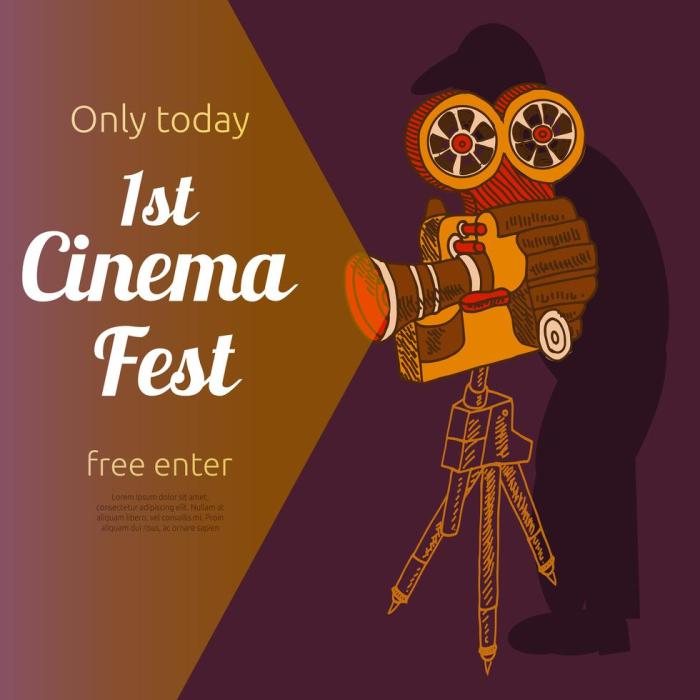Film Festival Posters: They’re more than just advertisements; they’re miniature works of art, encapsulating the spirit and promise of cinematic experiences. From the minimalist elegance of the 1950s to the vibrant explosion of digital design today, film festival posters have mirrored societal shifts and technological advancements. This exploration delves into the history, design elements, and impact of these compelling visuals, revealing how they shape audience perception and drive festival success.
We’ll dissect the evolution of design styles across decades, examining typography, color palettes, and imagery choices. We’ll analyze iconic festival posters, identifying recurring themes and effective strategies. Finally, we’ll uncover how these posters build brand identity, attract specific audiences, and ultimately contribute to a festival’s overall narrative. Get ready to see film festival posters in a whole new light.
The Impact of Film Festival Posters on Audience Perception

A film festival poster is more than just a pretty picture; it’s a powerful marketing tool that shapes audience perception and drives attendance. A well-designed poster instantly communicates the festival’s brand, tone, and target audience, influencing whether someone chooses to attend or not. The design choices—from color palette and typography to imagery and layout—all contribute to the overall impact and memorability.
A compelling poster can generate buzz, attract media attention, and ultimately, determine the festival’s success.Effective film festival posters act as concise narratives, instantly conveying the essence of the event. They need to be visually arresting, memorable, and effectively target the intended audience. A poorly designed poster, on the other hand, can lead to missed opportunities and a diluted brand identity.
Examples of Effective Film Festival Poster Design, Film Festival Posters
The Cannes Film Festival consistently delivers impactful posters. Their designs often feature minimalist aesthetics, focusing on a striking image—perhaps a close-up of a famous actor or a symbolic representation of cinema—paired with the festival’s logo and dates. This minimalist approach creates a sense of elegance and sophistication, aligning perfectly with the prestigious image of the festival and attracting a high-brow audience.
Conversely, the Sundance Film Festival often employs a more maximalist approach, incorporating vibrant colors, multiple images, and bold typography to reflect the festival’s independent and experimental spirit, thereby appealing to a younger, more eclectic audience. The contrast in style directly reflects the different target audiences and brand identities of each festival.
Comparison of Minimalist and Maximalist Design Approaches
Minimalist posters, like those frequently used by Cannes, prioritize simplicity and elegance. They rely on a single, powerful image or graphic element, clean typography, and a limited color palette. This approach works exceptionally well when the goal is to convey sophistication, exclusivity, or a sense of understated prestige. The focus is on quality over quantity, allowing the core message to resonate strongly.
Maximalist posters, exemplified by many independent film festivals, employ a more eclectic and visually busy approach. They often feature multiple images, bold colors, and diverse typography to convey energy, excitement, and a sense of inclusivity. This style is effective for festivals aiming to showcase a wide range of films and attract a broad, diverse audience. The key difference lies in the intended message and target demographic.
Social Media Campaign Mock-up: “CineFiesta Film Festival”
To showcase a hypothetical “CineFiesta Film Festival,” we could launch a social media campaign centered around a vibrant, maximalist poster. The poster itself would feature a collage of diverse film stills, bold typography announcing “CineFiesta,” and a playful use of color, suggesting a fun and inclusive atmosphere. The accompanying social media posts would use short, engaging captions such as: “Get ready for CineFiesta! 🎉 A celebration of independent film, vibrant culture, and unforgettable stories.
Tickets on sale now!” Visual elements would include short video clips showcasing highlights from previous years, behind-the-scenes glimpses of the festival’s preparation, and user-generated content encouraging audience participation through hashtags like #CineFiesta and #IndieFilm. The campaign would be targeted toward younger audiences through platforms like Instagram, TikTok, and Facebook, leveraging relevant hashtags and influencer marketing to maximize reach and engagement.
This multi-faceted approach would create a buzz and drive ticket sales.
Mastering the art of the film festival poster is about more than just aesthetics; it’s about strategic communication. By understanding the historical context, analyzing successful designs, and embracing innovative approaches, festivals can leverage these powerful visuals to create a lasting impact. From captivating imagery to compelling typography, the right poster can be the key to unlocking a festival’s full potential, driving attendance, and shaping its legacy.
The evolution continues, and the next great film festival poster is waiting to be created.